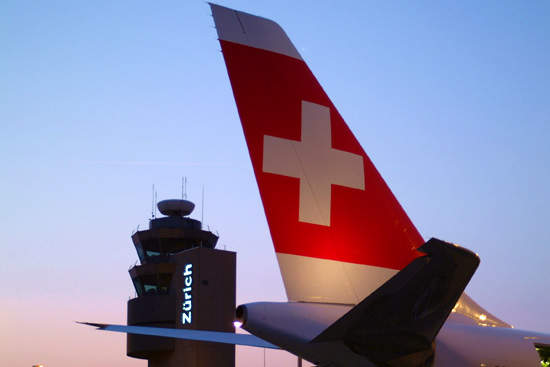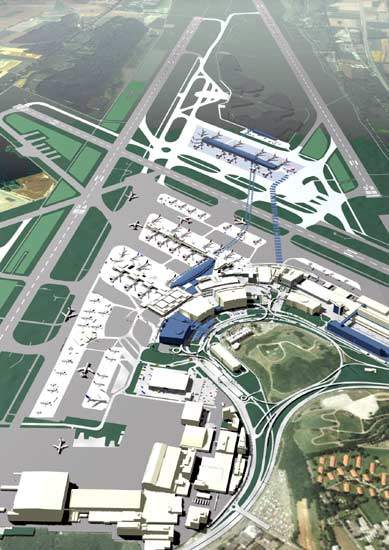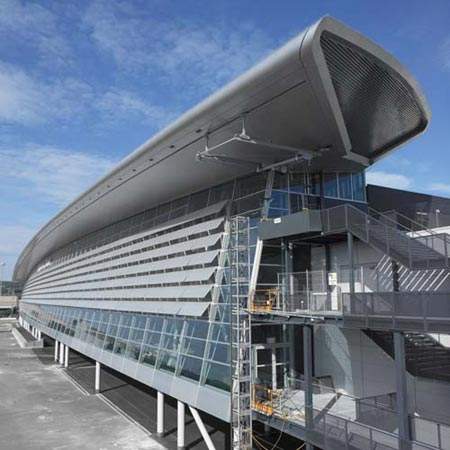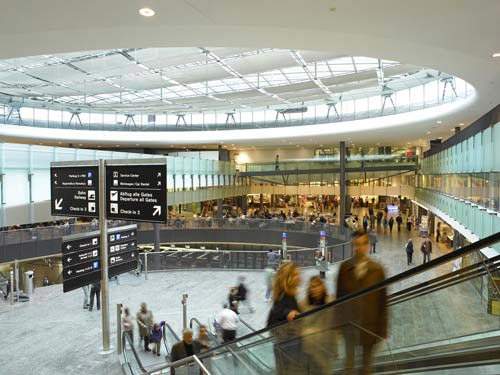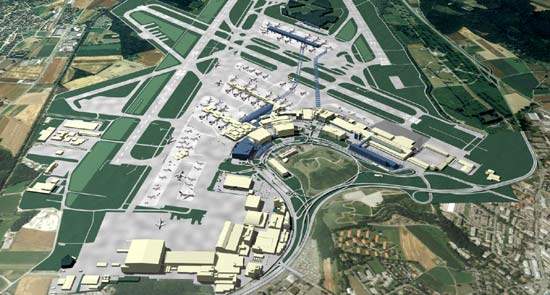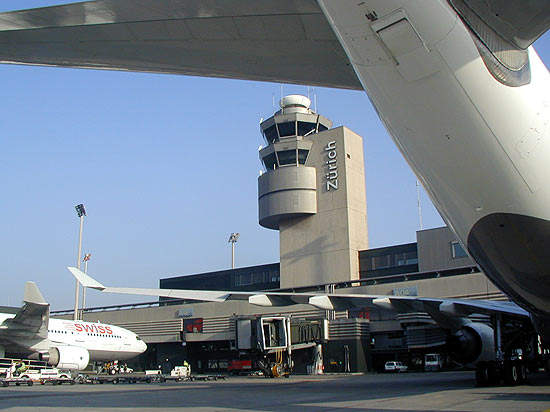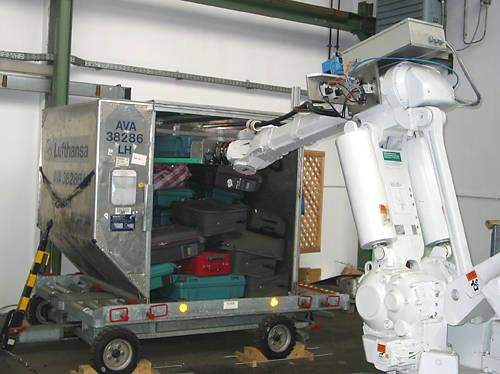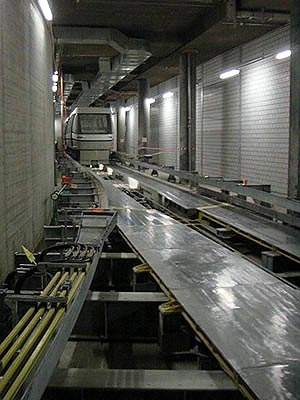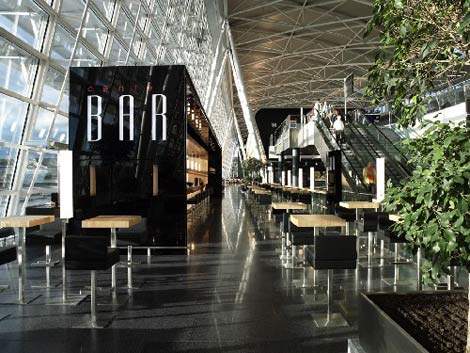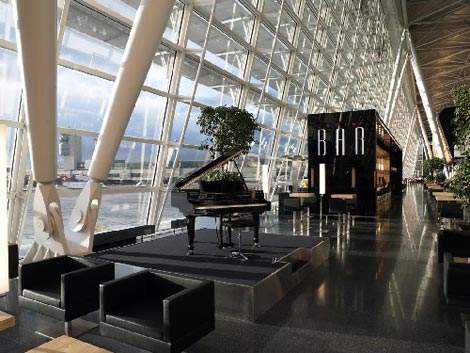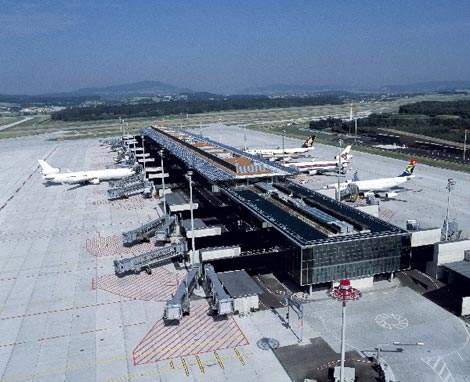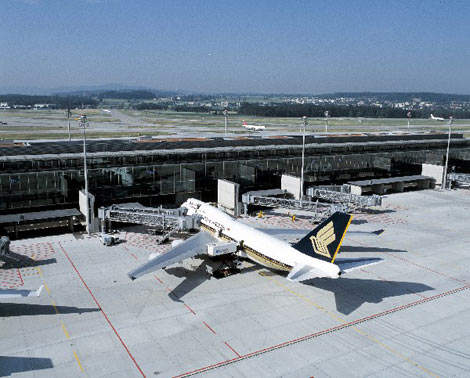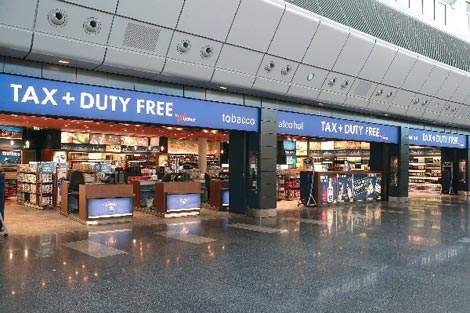The fifth airport expansion programme at Zurich International Airport (also called Kloten Airport) was developed to include the modernisation of existing facilities at the airport and to introduce new facilities and technology to make Zurich a first-class international airport.
The expansion required a total investment of CHF2.4bn, and included the construction of the airside centre (the new central hub of Zurich Airport), midfield pier (a new passenger processing terminal), the Skymetro transportation link, a new taxiway system with de-icing pads, a service tunnel for improved ground support and a new robotic baggage handling system.
The expansion also improved passenger transport links that included a restructured road system and improved rail links (new rail terminus).
The aim of the fifth expansion was to promote Zurich Airport into a position as one of the world’s leading air-transport hubs.
The fifth expansion was initiated in 1996 following planning approval in 1995. Construction work started in January 2000 and the new airside facilities were phased into operation at this busy airport up to mid-2005. The number of passengers passing through Zurich airport during 2005 approached 17.5 million (there were 19.2 million passengers in 2006).
Zurich airport received a serious set back after the terrorist events of 11 September 2001 and passenger figures, which were up to 22 million a year, took a tumble. This was compounded by the bankruptcy of the national airline Swiss Air in October 2001 (Swiss Air was a major operator from Zurich). The combination of these two events made some people doubt that the fifth expansion was such a good idea.
AIRSIDE CENTRE AND TRANSPORTATION CENTRE
The airside centre (250m long, 60m wide and 25m high) forms the centrepiece of the fifth expansion project and provides a connection between terminals A and B – it is the central hub of Zurich International Airport and an architectural showpiece.
The building has a wing-like roof and glass walls. It provides a central point for all passengers in departure, arrival and transit. A large mezzanine gallery incorporates restaurants, a shopping plaza, waiting areas and lounges. The airside centre also features check-in and transfer desks and immigration facilities. It is also the departure point for the Skymetro, linking to the midfield pier.
The new transportation centre is located at the entrance of Zurich Airport to improve passenger orientation and access to other parts of the airport. It links all road and rail access routes to a check-in level with 60 new desks.
Above the centre is the airport plaza, which has an abundance of restaurants and shops. This also includes the new rail terminal, of which one of the most striking features is a 900m² sky-light. The transportation centre also includes multi-storey parking facilities and information and service centres.
MIDFIELD PIER
The new midfield pier was designed to improve passenger processing, from terminals A and B to airside. It is strategically located between the triangle formed by the airport’s three runways to quickly deliver passengers and reduce taxi times.
At 487m long it is a building of impressive scale which uses aesthetic minimalism and an open double façade to concentrate on functionality, efficiency and low-energy concepts. It provides 27 extra gates to increase passenger and aircraft handling capacity.
SKYMETRO TRANSPORTATION SYSTEM
Skymetro is an air-cushioned Automated People Mover (APM) transport system supplied by Poma-Otis, which links the airside centre and midfield pier through two parallel, 0.7-mile tunnel links. It comprises a cable driven unit with three two-car trains (a third car can be added for additional capacity), each with a capacity for 92 passengers. The 1,138m travelling distance is traversed in just two minutes to provide frequent, quick delivery of passengers.
The system allows trains to circulate clockwise in a pinched loop between dock E and the airside centre stations. In a complete round trip a train uses four separate propulsion cables in series, changing cables at each station and at the two turn-back areas. Train movement is controlled remotely from a central control room.
ELECTROACOUSTIC DESIGN
WSDG Architectural Design and Consulting were awarded the contract for the electroacoustic design of both the airside centre and the transportation centre as a subcontract from Bassler and Hoffman.
The contract involved design and specification of electroacoustical systems by making full use of the software modelling system CATT Acoustic. This work allowed the positioning of loud speaker and announcement systems to be made to get the optimal sound.
The system used for the two large areas was based on Duran Audio’s Intellivox loudspeakers (16 units). These specially designed line array loudspeakers give full digital beam steering control and are small enough to be installed almost anywhere without being intrusive. Ancilliary loudspeakers were directional units supplied by Frazier and HK Audio.
BAGGAGE HANDLING FACILITIES AND SERVICE TUNNEL
A new baggage handling system was installed that can process 20,000 pieces of baggage an hour for a maximum of 15 minutes from check-in to aircraft. A newly constructed central sorting facility ferries baggage from three collection points to aircraft via a new service tunnel. The sorting facility features state-of-the-art X-ray and hazardous materials screening and high-speed conveyors for quick distribution to over 100 sorting destinations.
The new service tunnel also handles cargo transport and in-flight supplies. The tunnel is 675m long with four lanes and adjacent baggage and service conveyor channels. It provides a vital link between the new expansion and the rest of the airport.
Grenzebach Onero GmbH installed a robotic baggage loading system at Zurich in 2004 for an extensive 12-month field trial.
The system consisted of four modules: the baggage is optically scanned to determine weight geometry and type of bag; it is then identified by barcode or RFID; a load manager automatically calculates its best position in a load cart or container; and finally, a high-capacity computer controls the loading process.
The field test showed improved load efficiency, less damage to bags and fewer misloads. The handling costs per item of luggage were also significantly reduced.
In another innovation for Zurich, the airport installed the RampSnake bulk loading system (supplied by FMC Technologies, installed by Jet Aviation). The system is an automated ramp that uses individual powered rollers to deliver baggage, cargo or mail anywhere in the hold of an aircraft. The system can also be adapted to sort baggage as well and prioritise certain items. It has been suggested that RampSnake could speed the loading process by 20% to 25%.
TAXIWAYS AND DE-ICING SYSTEM
The most up-to-date technology has been used to enable Zurich Airport to handle up to 80 flight movements an hour. The new facility developments mean that the airport will almost double its amount of contact stands. With a higher density of traffic but an improved management system and taxiway layout the airport will be well positioned to lower turnaround times and reduce taxi times.
A new system for de-icing aircraft has also being installed. Two three-lane de-icing pads greatly reduce the amount of time aircraft need to spend on the ground in the winter.
UNIQUE – AIRPORT OPERATING COMPANY
The fifth expansion was carried out by an airport operating company called Unique. A new company, formed as a result of deregulation and privatisation in Switzerland, Unique, in collaboration with SwissairGroup and Swiss Federal Railways, developed the comprehensive expansion programme.
They have overseen all design and construction work to integrate the new facilities and technology into the airport system and to ensure the smooth operation of all parts of the airport.
Unique have been granted a 50-year concession to oversee operations at the airport and to advise and plan future expansions based upon passenger traffic. The company managing the airport is called Unique Zurich Airport Inc.
INFORMATION MANAGEMENT SYSTEMS
Unique have been instrumental in the introduction of a new information management system at the airport called ZEUS. ZEUS is a software-based, real-time airport activity monitoring and amendment system.
Unique could not get a system to fulfil all their requirements and so turned to NeuroPie and Zulkhe Engineering to build and install the software and required technology. Microsoft.NET were brought in to help with the software development.
ZEUS integrates technologies to process information and provide an understandable interface; the system was developed as a smart client application.
The software is installed on a number of workstations around the airport giving access to the ZEUS database, which is constantly updated with information from around the airport. For example, users can use CCTV to recognise and track aircraft and get a range of information from flight and boarding data to baggage handling status.
ZEUS is also fully integrated with the airport digital message boards. Airport status reports may be provided in minutes instead of taking a whole day.
Andrea Baroni, head of airport operations at Unique, said: “With the ZEUS system, we can look ahead and see where passenger loads are at a certain point. We can get live warnings about problems. And we can see where problems come up in specific areas.”
Josef Felder, chief executive officer of Unique, added: “An airport runs 24 hours a day, 365 days a year, so it’s very important for managers to have access at all times to important data so that we are informed on what’s going on daily.”

